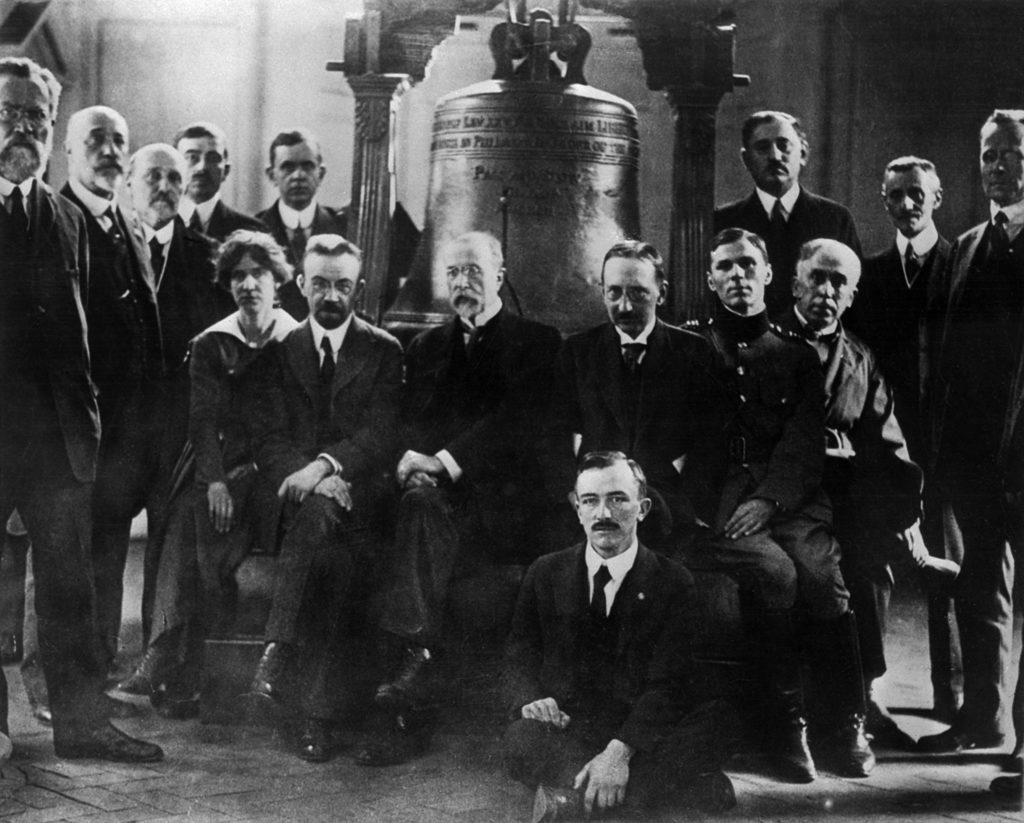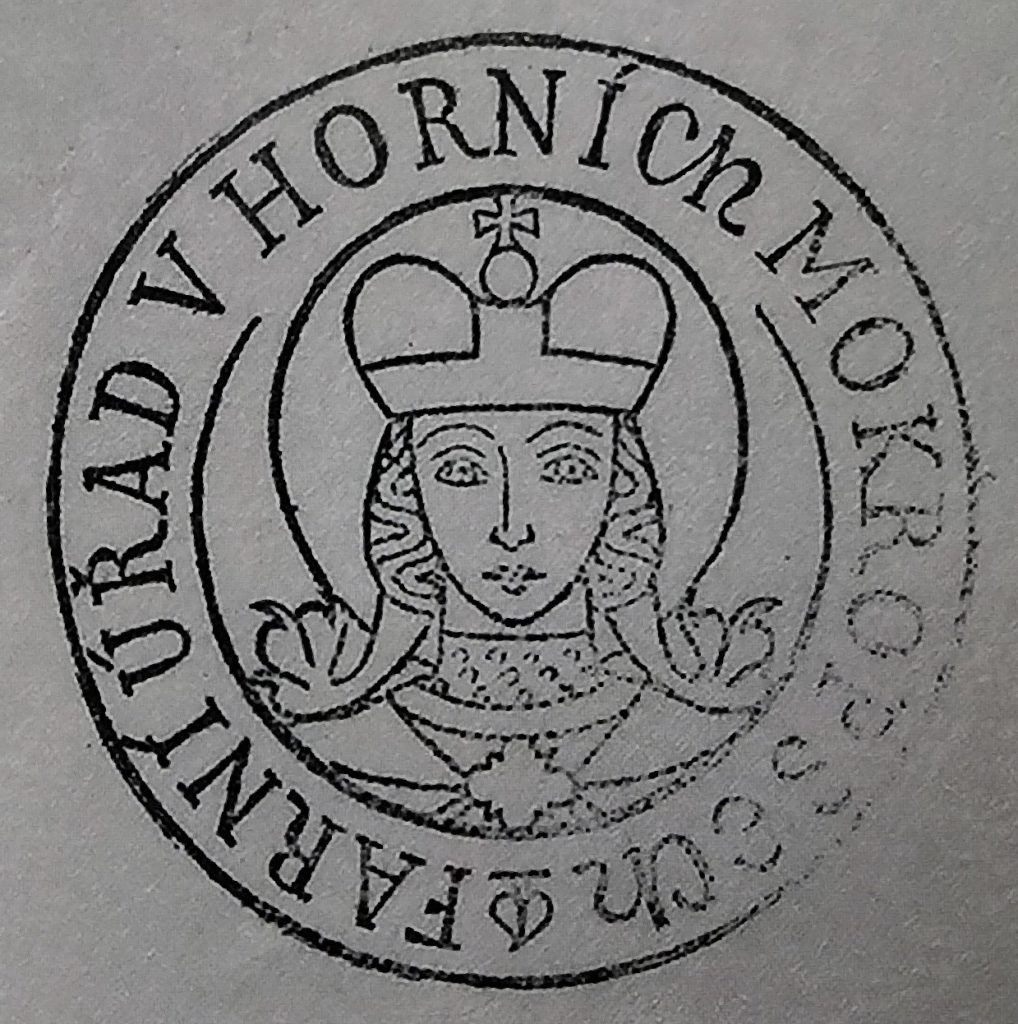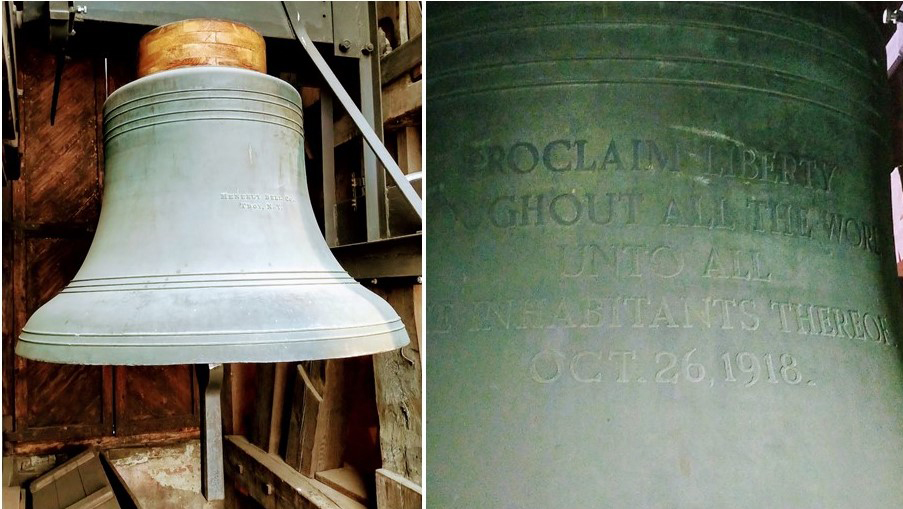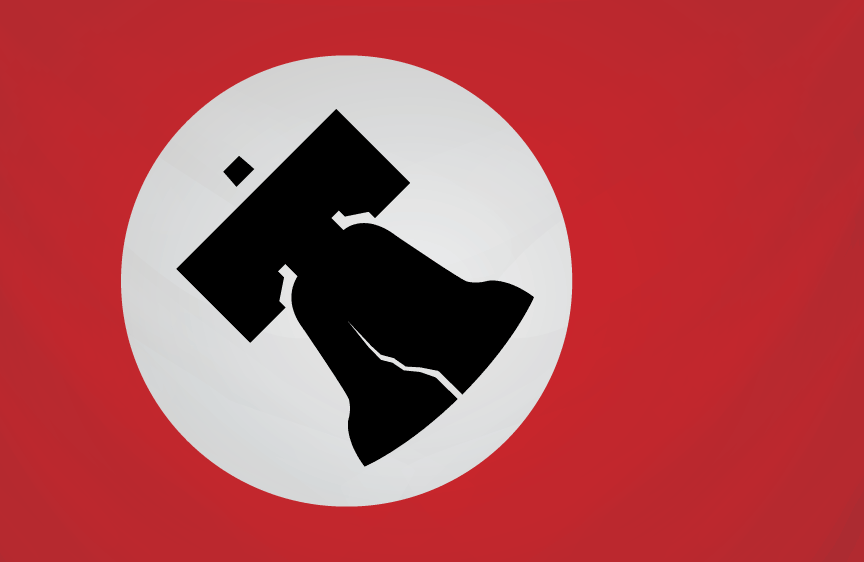The Democratic Mid-European Union Liberty Bell
Cablegram: May 6, 1940,
To: Herr Hitler, Berlin
“Only accurate replica of the Liberty Bell in Independence Hall, Philadelphia, was donated to Czechoslovakia by Americans when that country became a republic.
We understand all bronze articles are being melted down and since we have use for this valuable bell we offer $3,000 if delivered at New York in good condition for use in the World’s Fair.”
Signed: Richard P. Brown, State Secretary of Commerce, Pennsylvania, USA

How did a Liberty Bell fall into the hands of the Nazis? And why is a government official attempting to negotiate with Hitler seven months before America will enter the Second World War?
This story starts twenty-two years earlier, just as the first World War is drawing to a close.
A new Declaration
It’s the 26th of October, 1918, at Independence Hall in Philadelphia. Thick brown sycamore leaves crunch beneath the feet of men, women and children gathering on this brisk, overcast fall morning. Sixteen days from now, Germany will sign the armistice to officially bring the Great War to an end. But the process of instilling world peace and implementing Woodrow Wilson’s plan for self-determination has already started here in the cradle of American liberty.
The city is at the same time celebrating the hard-won world peace and grappling with a worldwide influenza epidemic that has crippled the city.
Carrying an extremely virulent strain of the flu, returning service members are welcomed in the streets by large crowds, providing the perfect conditions for the virus to spread rapidly. The problem is exacerbated as local hospitals are dangerously understaffed, their nurses and doctors still treating the wounded in France.
One-third of the city’s 1.6 million residents will become infected, 12,000 Philadelphians will die, and 50-100 million worldwide will perish.
Twelve men filter into Independence Hall and climb the stairs to be seated around a large table in Council Chambers. They are delegates of the aspirationally-named Democratic Mid-European Union, a loose affiliation representing some of the world’s most oppressed peoples. Many more are gathered outside the building, awaiting their fate. Across the Atlantic, some 65 million Slavs, Greeks, Poles, Jews and Italians, represented by the 12 delegates in Philadelphia, hope the promise of the newly-won world peace will deliver liberty from their oppressors and opportunity for a better life.
Seated in John Hancock’s straight-backed colonial chair is Dr. Tomáš G. Masaryk of the newly formed Czechoslovak Republic. Also present on this day is Gregory Zatkovich, an American citizen and spokesman for the American National Council of Uhro-Rusyns, seeking autonomy for his homeland of Carpathian Ruthenia, a rural mountainous region between Central and Eastern Europe and bordered by Poland, Romania and Hungary.
If not for the 20th-century attire, moving picture cameras and two Bohemian guards standing watch on either side of Masaryk, this could be 1776. The delegates are gathered here to declare their independence; independence from the Hohenzollern, Hapsburgs and Turks; independence for some of the world’s oldest nations; independence for nations whose borders have yet to be determined.
Among the local dignitaries gathered here today is department store magnate and marketing genius John Wanamaker. As the clock approaches noon, Wanamaker reaches into his breast pocket, pulls out the ceremonial signing pen, and hands it to Masaryk. At this moment, the sun breaks free of the clouds, filling the room with light. Wanamaker then unfurls an Americal flag, which he presents to the signers.
 Supporters of Mid-European independence gather at Independence Hall.
Supporters of Mid-European independence gather at Independence Hall.
Self-determination, American style
While the spirit of self-determination was to encourage the establishment of any type of nation and government the people choose, so long as the people choose it, the proceedings this day have a decidedly American flavor.
As a symbol of American support for their self-determination and a lasting reminder of the historical significance of this day, the people of the Mid-European Union are given a full size, functional Liberty Bell, minus the crack. Raised letters on the side of the bell read in English, a language foreign to all the delegates, “Proclaim LIBERTY Throughout all the Land unto all the Inhabitants Thereof.”
Cast in 1918 by the Meneely Bell Foundry in West Troy, New York, the bell might have been the nearest proximity to the real thing, which sits silently just inside Independence Hall, but it was not the first or only Liberty Bell replica. Meneely cast the Justice Bell, also known as the Women’s Liberty Bell, in 1915. The foundry had also produced two supersized replicas; the Centennial Bell in 1876 and the Columbian Bell in 1893 — both tipping the scales at an impressively symbolic 13,000 pounds.
Outside Independence Hall on this day of Mid-European independence, the brand new bell is christened by children representing the oppressed peoples. While the bell would have an incredible journey, the rope used to toll it did not travel far. It can be seen in the library of Dartmouth College in New Hampshire.
The bell would travel to the nation’s capital, then to the American Uhro-Rusin national congress near Pittsburgh before crossing the United States. Next, the bell was shipped to Europe, ultimately arriving in the city of Uzhorod in Carpathian Ruthenia.
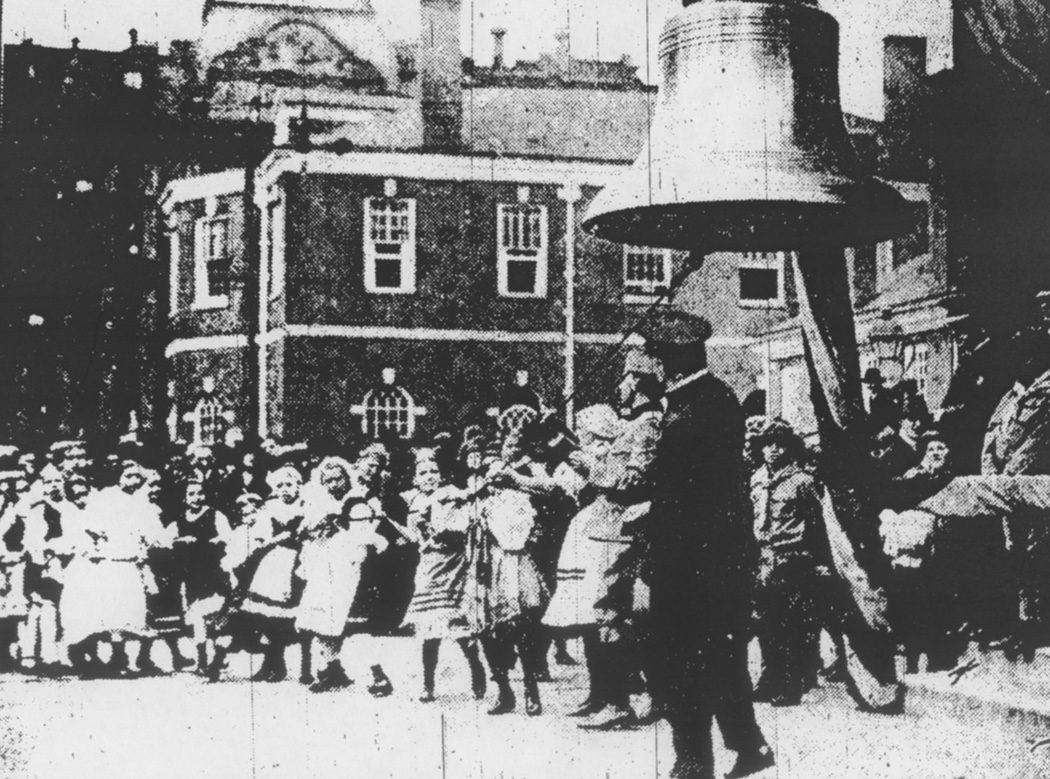
A tale of two leaders
Masaryk and Zatkovich, two of the 12 signers of the Mid-European Declaration of Independence, would follow separate paths as leaders of their people. Still, both would play a part in the fate of their shared Liberty Bell.
Less than a month after the ceremony in Philadelphia, Masaryk was elected as the first president of the new Czechoslovak Republic. By December, he was ruling his nation from Prague Castle. Masaryk served for 17 years before resigning in 1935 at the age of 85. He died two years later. In 1997 he resurfaced, appearing on the cover of the alternative metal band Faith No More’s Album of the Year.
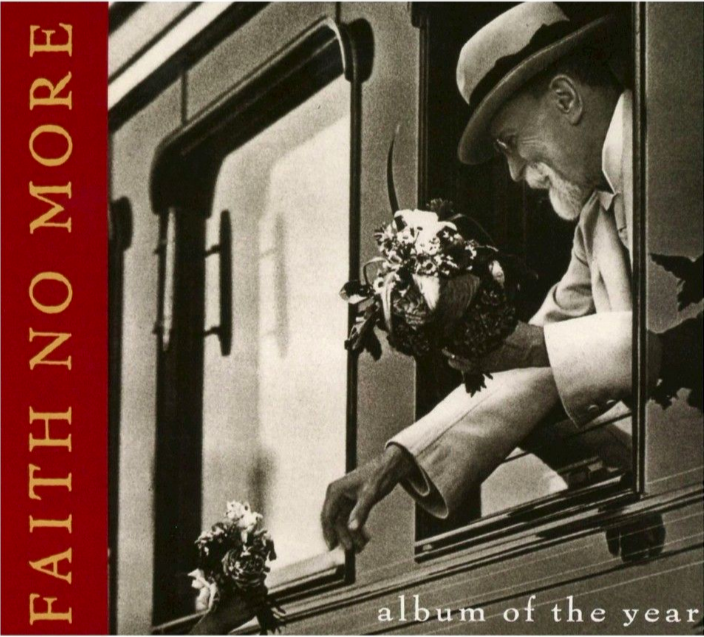
The George Washington of Carpathian Ruthenia
While the new Czechoslovak Republic would have a long history — first as a self-determined nation, next as part of the USSR, then as two self-determined nations, the Chech Republic and Slovakia — there is a reason most have never heard of Carpathian Ruthenia.
While the ultimate goal of Gregory Zatkovich and his people was to become their own nation after 1,000 years of foreign rule, he was willing to settle for autonomy as part of another nation. And so Carpathian Ruthenia came to be included as a state within Masaryk’s Czechoslovakia.
Zatkovich was elected governor but was hesitant to move to his new state for fear of losing U.S. citizenship. Woodrow Wilson and the state department assured the new governor his citizenship would not be in jeopardy.
Upon his arrival in the state capital of Uzhorod, Communists threatened to assassinate him. Zatkovich snuck in, in one of his nation’s two automobiles, disguised as the chauffeur. His family followed in the nation’s other car.
As the leader of his newly autonomous homeland, Zatkovich ruled from Zatkovich square. He had his own likeness carved in stone and painted in oil. He proudly brought the Mid-European Liberty Bell to Uzhorod. He resigned less than a year into his tenure over a border dispute with the state of Slovakia and returned to his law practice in Pittsburgh. There he continued to appoint knights, advocate for his people, and could often be heard at the piano playing the national anthem of Carpathian Ruthenia, which he wrote.
Zatkovich holds the unique distinction of having been the first person to head a foreign state while holding American citizenship and the only American to govern a region that later became part of the USSR.
Carpathian Ruthenia would get another shot at nationhood in 1991 when the Soviet Union collapsed. While 78% of residents voted for autonomy, self-determination eluded them once again, and the state was made part of independent Ukraine.
A break in the case
While it wasn’t a return cablegram from Hitler, Brown did get some leads on his missing Liberty Bell. On May 9 — three days after he publicly made his offer — it was revealed the Liberty Bell replica was not quite within the Führer’s grasp.
The clue came from Gregory Zatkovich. The former governor claimed the bell was still in Uzhorod, which was now under Hungarian control. When Germany invaded Czechoslovakia, Hungary wasted no time and swiftly reclaimed Carpathian Ruthenia.
Not so fast …
A week later, Zatkovich’s claim was refuted by former New York Times correspondent Edward T. Heyn. With President Masaryk’s support, Heyn brought the bell from Uzhorod to Prague, where it was placed on display in Prague Castle. There is was seen by thousands of visitors, especially Americans.
Heyn had a credible source. Emanuel Voska, a founding father of Czechoslovakia and a U.S. Army Captain, fled Prague for America just as the Germans invaded his homeland. He assured Heyn the bell was still in Prague when he left.
Evil at the castle gates
On March 15, 1939, Germany invaded Czechoslovakia with relatively little opposition. From Prague Castle, Hitler declared the Czechoslovakian regions of Bohemia and Moravia were now the Protectorate of Bohemia and Moravia, a semi-autonomous part of the Third Reich. The Führer would spend one night at the castle before turning it, and control of the region, over to Reinhard Heydrich. Called “the man with the iron heart” — by Hitler — the brutal Heydrich was the chief architect of the Holocaust and sought to crush opposition by suppressing Czech culture and executing members of the resistance. In 1942 Heydrich became the highest-ranking Nazi to be assassinated by resistance forces anywhere in Europe.
 Hitler at Prague Castle, March 15, 1939
Hitler at Prague Castle, March 15, 1939
Other affairs
Just as Heyn made his claim, Pennsylvania officially abandoned their effort to buy the Liberty Bell from the Nazis. “Mr. Hitler is too busy with other affairs,” said Brown.
Pennsylvania and the rest of the country would be busy with other affairs for the next five years. The Mid-European Union Liberty Bell had little chance of surviving the war. During World War II, the Germans melted down 150,000 bells, cast between the twelfth and twentieth centuries. 14,000 of those were taken from Checkoslovakian locations. As bells are easy to find and hard to hide, few were spared.
As the depths of Nazi atrocities came to full light, Hitler stealing the Liberty Bell became a trivial footnote, and the plight of the missing bell was largely forgotten.
A bell named Václav
It’s 6 p.m. on the 16th of July, 1980. At the church of Saint Anthony of Padua in Prague, Czechoslovakia, USSR, a mysterious bell finally gets its chance to ring out. The clergy have named it Václav. The Soviet state has granted the church permission to raise the bell to one of its two bell towers, so long as there is no public celebration.
The bell was sent there by the state in 1966 to replace one of the two bells that were pillaged during the war. However, the church was not permitted to call the bell into action, so it sat silently in the church hall.
As Václav swings into action and is about to peal out for the first time in decades, the inscription on its side catches the light of the sun.
“Proclaim LIBERTY Throughout all the Land unto all the Inhabitants Thereof”
Before the decade is through, the Soviet empire will crumble, and Václav’s true identity will come to light.

So did Hitler really steal the Liberty Bell?
In the broader sense that Hitler took Prague and the Liberty Bell was in Prague at the time, then yes, Hitler absolutely stole the Liberty Bell. Did the Nazis know they had stolen the Liberty Bell? Not likely.
It’s doubtful they knew anything about the bell — until a cablegram arrived from Pennsylvania, that is. However, it’s hard to know what, if any, effect Richard Brown’s stunt had on the fate of the Liberty Bell replica.
Did Hitler read the cablegram and send a squad out to find the bell? Surely the propaganda value of melting down the Liberty Bell was worth more than $3,000. Did a ragtag group of resistance members sneak a one-ton bell from one hiding place to another, staying just one step ahead of the enemy? As much as I’d love to write that story, I don’t think it happened that way.
Had the bell been sitting on display at Prague Castle when the Nazis rolled in, it certainly would have been melted down and turned into arms, as so many bells were.
As it was not melted down and there is no evidence of the Nazis knowingly possessing the bell, the most plausible scenario is that it was placed in storage sometime before the German invasion.
Following is the likely provenance of the Mid-European Liberty Bell. Thanks to fellow bell lover Ondrej Bohac from Prague for providing additional information.
1918: Meneely casts the bell. After the Independence Hall ceremony, it tours the country and is shipped to Europe. The cost is $2,000. It’s unclear who paid for it.
1919: The bell arrives in Europe.
1921: The bell is brought to Uzhorod, Carpathian Ruthenia, by Gregory Zatkovich.
1928: By Edward Heyn’s account, he discovered the bell in Uzhorod, lost and dust-covered. He then brought it to Prague, where it was placed on display in the hall of estates at Prague Castle. It’s unclear how long the bell was there. Heyn left Prague in 1934, and while he does not explicitly say, it can be inferred that the bell was still on display when he left Prague. Other accounts claim the bell was stored in a warehouse between 1920 and the mid-1950s.
1948: As the Communist regime takes hold, there is no room in Prague Castle for anything not in alignment with Communist ideology. So the Mid-European Union Liberty Bell moves to Wallenstein Palace, home of the State Heritage Institute. Architect Břetislav Štorm, an employee of the State Heritage Institute stencils the bust of St. Wenceslas (Václav in Czech) onto the bell. The bell is renamed Václav, an identity more in line with the state. Štorm pens a song for the occasion. Translated to English, the lyrics read, Saint Wenceslas, your people are calling you, return blessings to your country, return peace to your children.
The Catholic church is repressed under Communist rule. Many priests and monks are imprisoned. Others are persuaded to collaborate with the regime. One such collaborator is Antonin Stehlik, the parish priest from the church of St. Anthony of Padua in Prague-Holesovice and later canon at Prague Castle.
1966: Václav’s is transferred from Wallenstein Palace to the church of St. Anthony of Padua, likely aided by Father Antonin’s closeness with the regime. It sits silently in the lobby for 14 years. Officials consider scrapping the bell and using the metal to cast a new one. Manoušek, a family-owned Czech bell foundry inspects the bell and determines it’s up to the job, with some modification. The bell was made as a signal bell, where only the clapper moves to ring the bell. To work in the belfry, it would need to be converted to a classic swing bell, where the entire bell swings to ring.
1979: Cardinal František Tomášek grants approval for Václav to be installed in the bell tower. He also dictates there is to be no public ceremony.
March 20th, 1980: Father Antonin’s successor, Father Josef Kubalík blesses the bell. The next day it’s installed in the north tower in a delicate four-hour process.
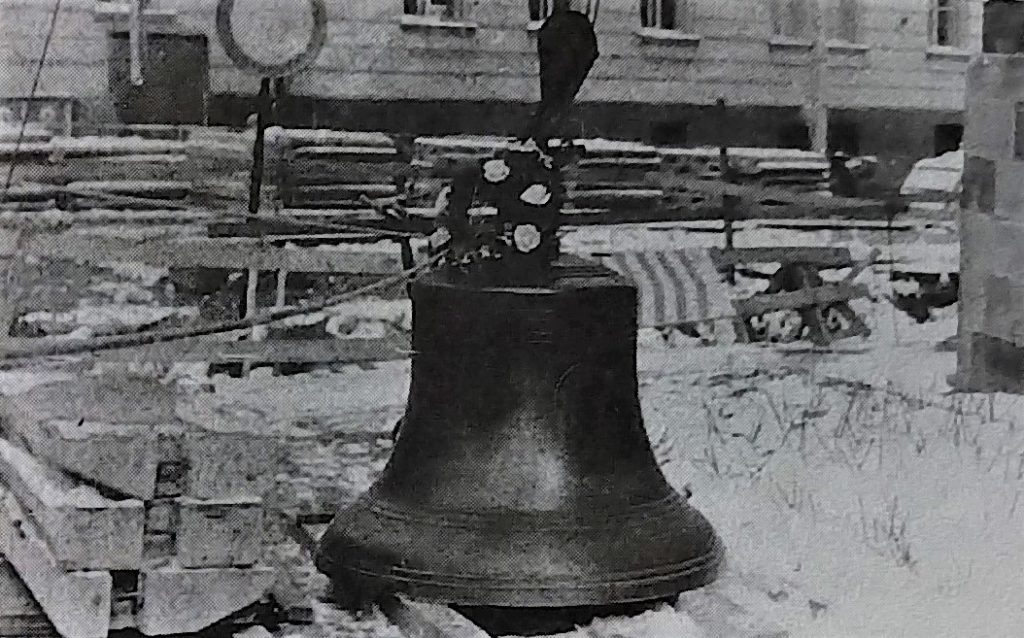
July 16th, 1980: At 6 pm. Václav rings out from his new home for the first time.
The luck of Liberty
I think the bell was ultimately saved, not because it was revered, but because it was neglected. Like other Liberty Bell replicas, the Mid-European Union bell was cast with no permanent location secured. Once it arrived in Uzhorod, the other Declaration singers likely paid it little mind.
I think it was revered in Carpathian Ruthenia during Zatkivich’s brief tenure and then mothballed.
Likewise, I think it was admired upon its arrival in Prague for some period of time, then stored away. It’s reasonable to think the castle would rotate displays. A 1,000-year-old castle has a lot of history, after all.
Václav rings daily at 7 a.m., noon, and 6 p.m. Along with the Annecy Liberty Bell, it is one of only a few replicas to be regularly used as a bell.
Liberty works in mysterious ways, and while the story of the Mid-European Union Liberty Bell is little known, and the bell now known called as Václav receives little adoration, it’s mere existence is a testament to the spirit of those who gathered at Independence Hall in 1918 to proclaim liberty throughout all the land, unto all the inhabitants thereof.

